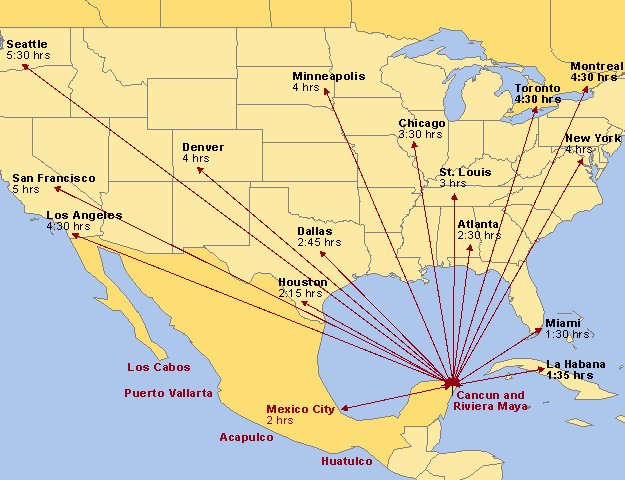It is located at a distance of 370 km from the capital of the state of Quintana Roo, (Chetumal), 70 km from Playa del Carmen, on the eastern side bordering the Caribbean Sea, in the west with the municipality of Lázaro Cárdenas, towards The north with the municipality of Isla Mujeres and the south with the municipality of solidarity. The total size of the territory is 1664 km and 22 km of coast, is northeast of the Yucatan peninsula and only 7 km from Isla Mujeres. Cancun is geographically divided into 5 zones:
Hotel Zone: This is considered the most important part given that it is the part that gives the sea and most of the tourist activities that is the main economic source of this destination. It houses most of the hotels, residential areas and beaches, the Pok Ta Pok golf course and the entrance to Cancun port, this island is linked to the mainland by three bridges; The Calinda bridge at km 4, then the Club Med bridge at km 20 and finally the Nizuk bridge at km 22. In the center of this island is the Nichupté lagoon, which is composed of 7 bodies of water: Laguna Bojórquez, Cuenca del Norte, Cuenca Central, Cuenca Sur, English River, Del Amor, and Lagunita del Mediterráneo.

Urban zone: this refers to the center of the city, where the majority of the population lives, which in turn works in the hotel zone, is not frequented by most of the tourist population although it has many attractions including monuments and Museums, in this area is located most of the governmental, educational and cultural institutions and are divided into super apples mainly.

Puerto Juárez: In this area there are two main docks that are used to embark to Isla Mujeres, which is dedicated mainly to fishing. It consists of three supermanzanas, the 86 that reaches the ruins of El Meco and 84 and 85 which are mostly dwellings. It has several palapas, several of them abandoned, although it is a great option to eat in one of its many restaurants of fish and seafood, this thanks to that the majority of the inhabitants of this zone are fishermen.

Franja Ejidal: in this area are settlements that are distributed irregularly in the northern part of the city, on the border with the municipal boundaries of Isla Mujeres. Here live a part of the poorest population, many immigrants from other parts of the country.

Coastal Zone: This is a strip of white sand that runs all the eastern side of the municipality, most of it is the hotel zone, counting with 9 public beaches: Playa las Perlas, Playa Langosta, Playa Tortugas, Playa Caracol, Playa Chac mool, Beach Marlín, Playa Ballenas, Playa Delfines (the famous Mirador) and Nizuc Beach.

13,154 total views, 6 views today


